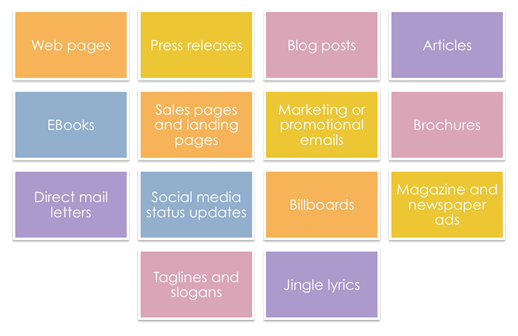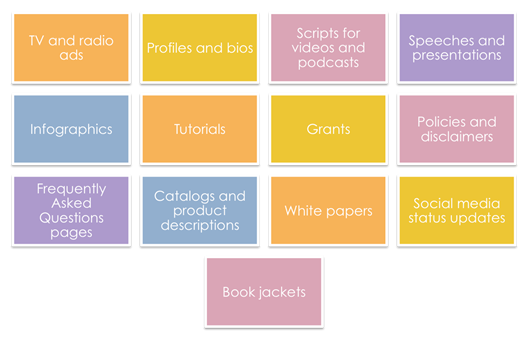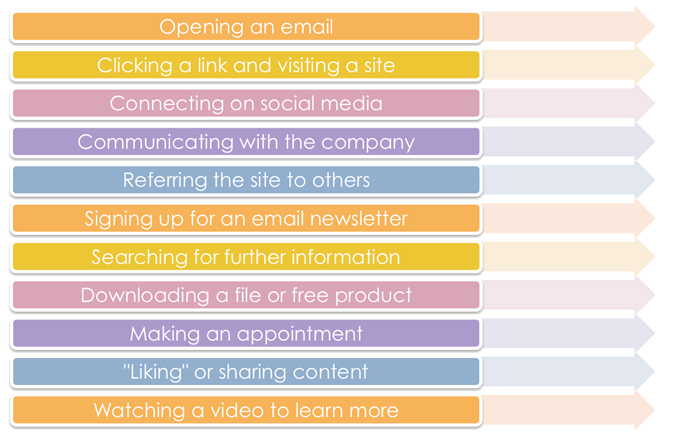Welcome to
LEARN COPYWRITING FOR SMALL BUSINESSESFormulas for Words That Convert
Introduction
“”Copy is a direct conversation with the consumer.”
– Shirley Polykoff
Today, in our digital world of visual content and immediacy, good writing is as important to businesses as ever. Copywriting is essential for communicating the value of your company’s offering to its potential customers. Content drives online marketing and sales, and copywriting is at the core of all content, whether it’s a long-form sales page or a 140-character tweet.
Good writing can make a significant difference in your sales and online conversions, while bad writing can sabotage your marketing efforts. Far too many small businesses delegate their copywriting to any busy employee who will do it. Companies that understand the importance of copywriting hire professional copywriters, but copywriters aren’t cheap. For businesses on a tight budget, being able to write copy yourself is extremely helpful. In fact, even if you are able to hire a copywriter, it pays to know the basics of good copy since you’ll need to evaluate the work.
Luckily, while copywriting is definitely a skill you need to master, it isn’t nearly as difficult as it’s often believed to be. Much of what goes into it isn’t the actual writing, but knowing the target audience well and choosing the right words that will appeal to that audience.
With this understanding of your audience and some of the basic copywriting skills you’re going to learn in this course, you can improve your existing copy and write new copy that gets better results for your business.
What You Will Learn in This Course
By the end of this course, you will have learned various copywriting techniques and time-tested formulas for creating the kind of copy that converts visitors to buyers. However, you’ll use your new writing skills for far more than just sales pages. You can also use them in any area of your business where you need words to persuade people to take action.
You’re going to get clear, straightforward guidelines on what to include in your copy, along with real-life examples. Along the way, you’ll learn how to grab your reader’s attention and maintain it throughout your copy, leading the reader eventually to take a recommended action.
In addition to writing the persuasive content of your copy, you’ll also learn basic SEO tips to help you write in such a way that search engines will help visitors find your content.
While you’re going to be learning some time-tested copywriting formulas to use right now, formulaic writing isn’t the most effective copy in the long run. What’s most effective is unique writing that speaks directly to your target audience. As you continue to write, you’ll discover your own unique style that’s effective in communicating with your readers.
Finally, you’ll learn some quick tweaks you can make to the formulas you use that will give your copy greater impact and increase conversions.
Learning Objectives
By the end of this course, you’ll be able to:
- Clearly define copywriting and identify ways you can use it in all areas of your marketing to help your business grow.
- Use several copywriting techniques right away that will improve the results of your current sales or marketing copy.
- Take one sales letter, web page, or other piece of marketing content and apply the AIDA formula to create copy that converts and urges your reader to take action.
- Pick 2 SEO techniques that you can use to help your web copy get found and indexed by Google and apply them to your website, sales page or online product page immediately.
- Identify the techniques and strategies used by companies that excel at copywriting and brainstorm ways you can use these tips in your own copy.
- Create an action plan for updating existing copy and improving it using the copywriting techniques you have learned
What Is Copywriting?
Traditional copywriting is the process of writing advertising or promotional copy. The text on any advertisement, promotional mailing, magazine or newspaper ad, sales letter, website sales page, billboard, or anywhere else where someone is selling something is copywriting. It’s any kind of writing that offers a product or service for sale and this is why a copywriter is often referred to as a “salesperson in print.”
Your copy is a marketing tool for your business. It explains your product or service and the value your product or service offers the buyer. It’s a message to your target market that convinces them that your offering is worth the purchase price.
Copywriting is used on:
- Web pages
- Press releases
- Blog posts
- Articles
- EBooks
- Sales pages and landing pages
- Marketing or promotional emails
- Brochures
- Direct mail letters
- Social media status updates
- Billboards
- Magazine and newspaper ads
- Taglines and slogans
- Jingle lyrics
- TV and radio ads
- Profiles and bios
- Scripts for videos and podcasts
- Speeches and presentations
- Infographics
- Tutorials
- Grants
- Policies and disclaimers
- Frequently Asked Questions pages
- Catalogs and product descriptions
- White papers
- Social media status updates
- Book jackets


In other words, you see traditional copywriting anywhere that anything is being advertised or sold.
The purpose of copywriting is to lead the reader to take action. A common action to urge is to make a purchase, but not all copywriting is used to sell directly. Other actions it may lead readers to take include:
- Opening an email
- Clicking a link and visiting a site
- Connecting with the company on social media
- Communicating with and engaging with the company
- Referring the site or company to others
- Signing up for an email newsletter or email list
- Searching for further information
- Downloading a file or free product
- Making an appointment with the company for something like coaching or consultation
- “Liking” or sharing content on social media
- Watching a video to learn more

The goal of your copy can be any kind of action. These actions are counted as “conversions.” When a visitor takes the desired action, we say that your site has gotten a conversion. Website analytics programs measure conversions and this is how you can tell whether your copywriting is effective or not.
Why is Copywriting Important?
There are several reasons copywriting is important, but the main one is simply that words matter. Every single word you use has the potential to impact a person’s thinking. This is why Facebook decided to change its earlier “Become a fan” button to the “like” button. The reason is that Facebook found that this simple change in wording led to users clicking the button twice as often. Perhaps the psychological reason behind this is that people feel less committed to something when they “like” rather than “become a fan.”
Copywriting often offers the first contact a business has with its customer. Since your first contact makes a lasting impression, good copy is a necessity.
What good copywriting does is grab the customer’s attention and keep that attention so that they keep reading, which isn’t easy to do with so much other noise out there. Along the way, good copy evokes emotions that lead the reader to take the desired action, whether it’s to buy a product, sign up for a newsletter, follow on social media, or click a link to find out more information.
Copywriting is important especially on the web because it grabs attention and communicates benefits quickly. It’s especially hard to gain and maintain attention spans online. According to website Econsultancy, five times as many people read the headline as read the body copy. This shows how important it is to have a powerful and succinct headline. Headlines are an area where copywriting really counts.
Copywriting also highlights the most important information and brings it front and center. Research by Sumo, found that only 20% of readers finished their articles. Not only that, the average visitor would only read 25% of an article. Good copywriting ensures that the most vital points stand out.
Finally, good copywriting effectively communicates your business’s message so that your customers better understand you. It conveys your brand and company culture, bringing in new customers and making them feel closer to your business. Good copywriting shows your readers the value your company offers and it can show that you’re addressing the issues that matter to your readers. Through the power of your good copywriting, you can effectively grow your business.
Many businesses spend a great deal of time choosing and refining their marketing techniques, only to neglect the copy they use to communicate with their customers. This is a huge mistake. Improvements to all your words can have a much more powerful effect on conversions than any SEO technique or marketing trick.
Activity:
Visit your own website home page, a product/service sales page, or other main piece of marketing material you’ve been using for a while.
Ask yourself:
- What would my first impression be if I didn’t already know my company or product/service?
- Is the content up-to-date?
- Does the copy portray my company in a professional manner?
- Are there typos or formatting errors on the page?
Jot down some notes about anything you notice to refer back to later on.
A Word
From Tamara
As an entrepreneur myself I completely understand the stress, anxiety and frustration around launching or growing a business. I also know the rewards and life style change the hard work can provide you if you stay focused. I am here to inspire and motivate you to push forward. The fact that you’re investing in your business education let’s me know you’re in this to win. Rest assured I’m here to help you…. These courses are set up to help you understand the basics. To dig deeper into your specific plan of action we will discuss where you are, where you want to be, eliminate any blocks preventing you from getting to the next step and create an action plan.

Our superpower is making you a superhero.

